8. Reading Development: Engaging Emergent Readers
“The fire of literacy is created by the emotional sparks between a child, a book, and the person reading. It isn’t achieved by the book alone, nor by the child alone, nor by the adult who’s reading aloud—it’s the relationship winding between all three, bringing them together in easy harmony.”
–Mem Fox, from Reading Magic: Why Reading Aloud to Our Children Will Change Their Lives Forever.
8.3 How Emergent Readers Progress
8.4 Fostering Emergent Readers
Opening Vignette: The Favorite Book
One morning a young 2-year-old named Adelyn was sitting with a favorite book from home, “Dora and the Rainy Day.” Ms. Faith, Adelyn’s home care provider, watched on as Adelyn flipped back and forth between the pages of the well-loved boardbook. She repeatedly came back to a page in the beginning and pointed to the words and the pictures and said, “It’s time to come inside now. It’s raining.” Then she would flip to the middle of the book and stop. Clearly mimicking the intonation of an adult who had read the book before, she said, “We are making hot chocolate…need to wait for the cookies to bake!” Then she moved to a page at the end of the book and pointed to the characters in the picture saying, “That’s the mom…there’s the dad….it’s raining.” Then she closed the book and announced, “THE END!”
Ms. Faith walked over to the child and commented on what a good job she did reading the book. Ms. Faith also asked Adelyn to show her some of the parts of the book, noting that this child was clearly showing signs of print awareness. For instance, she observed that Adelyn was holding the book right side up, she turned the pages from right to left (even though she skipped some), and she was able to use known words and concepts from the story in her retelling. It was clear to Ms. Faith that Adelyn was developing a sense for story structure and how to use pictures and words to understand text. And best of all, Adelyn was finding great joy and pleasure in rereading this book on her own.
8.1 Introduction
Watching a young child, like Adelyn in the opening vignette, begin to understand how reading works is such an exciting time for both families and early childhood educators. As has been discussed in previous chapters of this textbook, there are many interwoven elements that create proficient readers and many things adults can do to support reading development. Through continuous exposure to a variety of text, repeated readings of favorite books, and conversations between adults and children about text, children like Adelyn learn that reading is ultimately about making meaning and communicating a message. Even though this particular child has not yet learned to read in the formal sense, she knows a lot about print and how books work. These emergent reading skills are critical to future reading success and an ability to ultimately “crack the code” and recognize that letters and symbols connect to sounds and meanings (Scarborough, 2002). Knowing that text conveys a message supports children’s developing abilities to understand and eventually decode that message independently.
For some children, it might seem that reading starts to happen “like magic” but learning to read is not intuitive. This differs from how children acquire language. The human brain is wired for language and children naturally gain language skills as they develop (Chomsky, 1968; Geary, 1995; Snow, 1983). Some researchers refer to language as “biologically primary” because it is found across cultures and needed to help people survive (Geary, 1995). However, this is not the case for reading the printed word because what we read—our alphabetic script—is an invention, only available to humankind for the last 3,800 years (Dehaene, 2009). As a result, our brains have had to accommodate new pathways for translating the squiggles that are letters into the sounds of the spoken words they symbolize.
The seemingly simple task of reading is, in actuality, a complex feat. Reading skills require a complex interplay of various regions of the brain working together simultaneously (Wolf, 2007). Reading skills are considered “biologically secondary” because they do not develop without specific experiences and instruction (Sénéchal et al., 2001). Children need intentional and explicit opportunities to learn skills and strategies to become proficient readers. In this chapter, we will use a Framework for Developing Emergent Literacy (Puranik & Lonigan, 2014), including conceptual knowledge, procedural knowledge, and generative knowledge, to unpack the complex elements of reading.
Figure 8.1 “Framework for Developing Emergent Literacy”
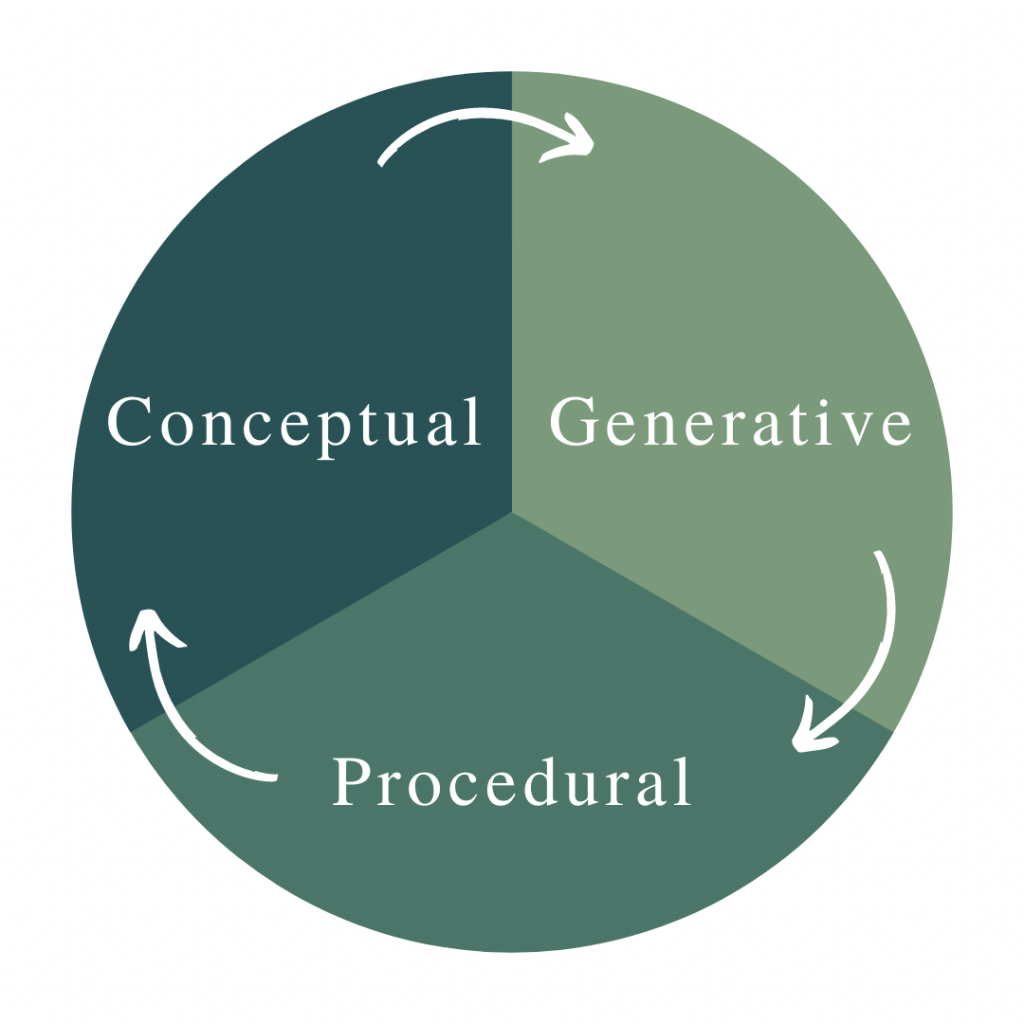
This framework was designed to explain the dimensions of emergent writing. But in this textbook, we will use the framework to parallel both the reading and writing processes. The first dimension, conceptual knowledge, will focus on the functions of reading, such as learning new information, completing a task, or reading for enjoyment. The second dimension, procedural knowledge, will focus on the mechanics of reading, such as decoding, print orientation, and story structure. Lastly, the third dimension, generative knowledge, will focus on application of skills, such as understanding the author’s meaning and applying information or ideas in the real world. Using the Framework for Developing Emergent Literacy, this chapter will answer the following questions:
 How do young children develop an understanding that reading is about making meaning?
How do young children develop an understanding that reading is about making meaning?
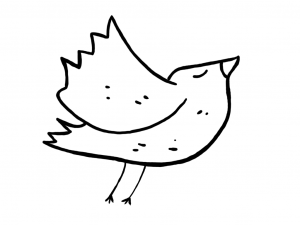 How do emergent readers progress on a continuum of development?
How do emergent readers progress on a continuum of development?
 What can early childhood educators do to support emergent readers using effective instructional strategies and literacy assessments?
What can early childhood educators do to support emergent readers using effective instructional strategies and literacy assessments?
8.2 Reading is Making Meaning
Children at a very young age begin connecting print and other symbols to meaningful ideas. Anyone who has seen a child “read” a sign on the side of the road for their favorite restaurant or store has witnessed this process of making meaning. Children know that when they see the familiar sign, it is marking something meaningful and letting people know what they can find inside. The processes of “learning to read” and “reading to learn” develop concurrently in an incremental and symbiotic fashion. A 3-year-old looking intently at a picture book with characters wearing hats is reading to learn about hats. At the same time, that toddler is hearing sounds /hat/ that match the symbols on the page. They are seeing and hearing it as a whole word, which helps build a foundation for learning to read. Conceptual knowledge about reading can and should happen well before formal reading instruction or the process of “learning to read” begins. Before children can independently read words on a page, they need to know that print conveys a message. This conceptual knowledge about the basic functions of reading is fostered by experiencing print in a variety of meaningful contexts.
Text and text features (e.g., charts, headings, and captions) in books work similarly to signs on the road. When children have guided and supportive experiences in text, they begin to make connections between elements of print and its meaning. Adelyn, in the opening vignette, could not read the words “cookies,” “hot chocolate,” and “raining” but she could point to the text and indicate that she understood that the words on the page talked about important elements of the story she had heard before. Likewise, children also understand that they can learn from print well before they can formally extract a message themselves. It is not uncommon to see young children locate resources that they know contain information they want or need. In early childhood classrooms, children will often bring a book to their teacher and ask them to read the part about their favorite animal. At home, children may ask a caregiver to read the next step of the recipe so they know what to add to the cake batter. These are all early markers that children are connecting reading with making meaning. There is no arbitrary line when children learn to read and then can learn from reading. When exposed to print and text messages, children are in a continual process of both learning the skills needed to read and learning new information from text.
In this textbook, we are positioning early childhood teachers’ first, and arguably primary, responsibility around reading instruction to be fostering meaning-making experiences to ensure that children see reading not just as isolated skills, but as a process that ultimately shares a message. Early childhood educators support students’ conceptual knowledge about reading and help children understand the purpose of text when they (a) connect spoken words to print, (b) share various types of text, and (c) guide comprehension of text. Later in this chapter, we will discuss a variety of instructional strategies and assessments educators can use to build specific emergent literacy skills, but here we will discuss how to develop a conceptual understanding about print.
8.2a Connecting Speaking to Print
In Chapter 7, we discussed the critical role that oral language and vocabulary play in literacy development. Early childhood educators can build an understanding about reading by connecting children’s language skills to print. This can be as simple as stating a student’s name and then pointing to the name on a chart or having children say or echo read the letters that make up the special friend’s name. Educators also show children how oral words are represented in print when children dictate captions that go with their illustrations or create collaborative morning messages about the day’s events. Even if the children can’t read all of the words being written, the educator is reinforcing that their words can be marked using symbols. Educators can also ask students to orally share their background knowledge on a topic and then turn to a written text to see what the author has to say about the topic. Ultimately, we want children to know that what we think and say can be written down and what we write can later be read and discussed.
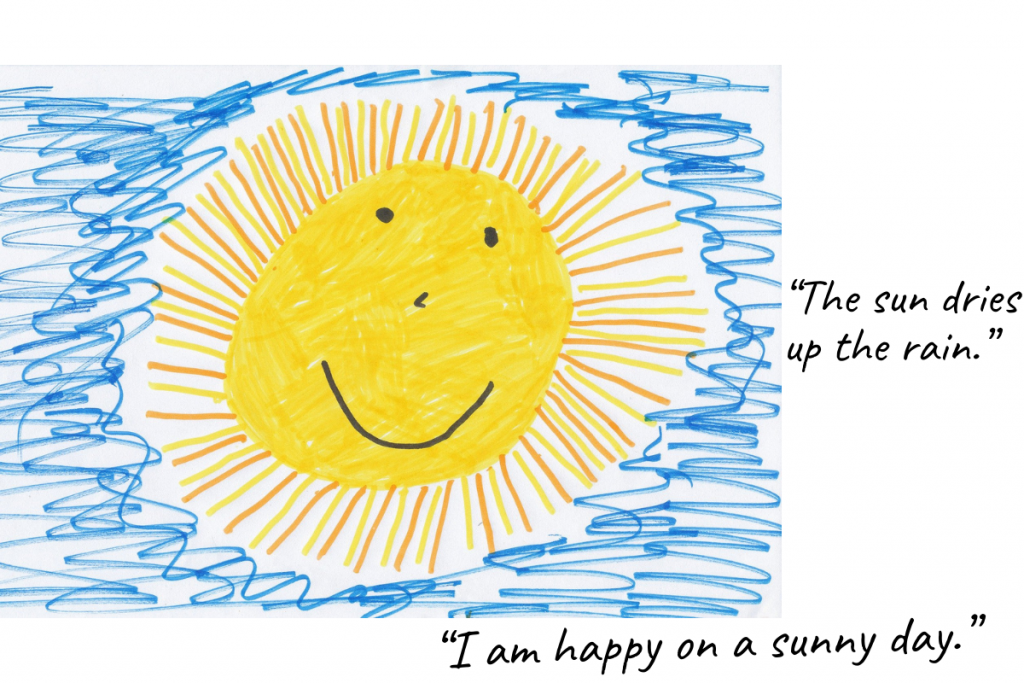
8.2b Sharing Various Types of Text
Helping children see that text is part of our world and all around us is a big piece of the early childhood educator’s role in reading development. Using environmental print, familiar signs, logos, and brands to show children examples of text they know can be a powerful learning experience. Educators can also intentionally choose a variety of books to share with children. Ensuring that children have access to various types of books and text, such as board books, cloth books, pop-up books, magazines, posters, labels, etc., helps children see the various forms that print can take. It is also critical that educators read daily to children from books of varying genres. Finding picture books that share engaging fictional stories is just as important as finding non-fiction books about topics of interest. Reading poems and comic books as well as recipes, directions, and lists shows children that text shows up in a plethora of ways for different purposes.
8.2c Guiding Comprehension of Books

Children learn about text features when they share books with educators.
Once children have been immersed in text and see its prevalence all around them, they are ready to have guided discussions about understanding various types of books. Early childhood educators can begin thinking aloud about what they notice as a story unfolds and what they are wondering as new events and details emerge. Helping children develop an awareness of basic story structure (e.g., problem and solution; beginning, middle, and ending; setting and characters) primes them for future independent reading and unlocks some of the mystery around storytelling. These opportunities for guiding comprehension and understanding of books support children’s developing knowledge that reading is an active process. In order to understand the message, they need to engage with print in various ways. Similarly, educators can point out various text features of non-fiction text (such as photographs, captions, headings, charts, etc.) to show children that important information can be found in many places. Comprehending text is a continuous skill that deepens and matures throughout the reader’s life, but the initial keys to understanding text can be nurtured from the earliest years.
8.3 How Emergent Readers Progress
Emergent literacy (defined in Chapter 1) acknowledges that literacy development is an emerging process that begins well before children demonstrate proficient reading abilities. When a child sees a sign for a favorite restaurant along the road, looks at a box of cereal while eating breakfast, or flips through a magazine looking at the pictures while waiting at the doctor’s office, they are benefiting from ongoing exposure to print materials. Similarly, when hearing proficient readers share stories, like when a family member reads before bed or an educator shares a picture book at circle time, children are learning about reading. These everyday experiences support children’s emergent literacy skills and contribute to their future reading proficiency.
Because of the emergent nature of literacy development and its dependence on the experiences, exposure, and environment of the child, reading skills progress in an individual fashion. A child’s chronological age will not automatically tell us what a young reader will need; however, young children’s reading abilities typically develop in stages along a continuum. Having an understanding of these stages of reading helps early childhood educators recognize where children are in their development, regardless of age. The stages of reading development give educators a road map to know what children need to know next to continue on their literacy journey. Stage criteria or indicators show educators the procedural knowledge, or understanding of the mechanics of reading, needed to effectively build upon young children’s reading abilities.
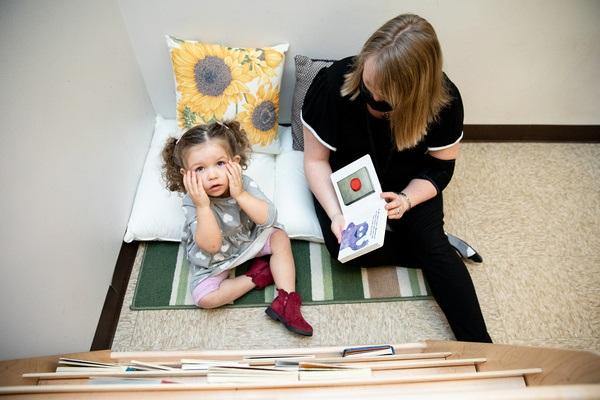
8.3a Emerging Readers
Researchers use a variety of models to represent the progressive skills and proficiencies children acquire over time (Chall, 1996; Clay 1991; Whitehurst & Lonigan, 2002). As children internalize specific reading skills they use the skills in an integrated manner to interpret and respond to text. There is an age range that can be considered “typical” or expected for each of the stages. For instance, we typically see children in the preschool years developing emergent reader skills. However, these stages are not always age specific and sometimes children move more slowly or quickly than would be expected. Some children under age 5 begin showing signs of early reading skills while some kindergarten students are still developing emergent skills. It is important that early childhood educators use appropriate assessment techniques to observe children’s current stage and level of functioning.
There are a number of descriptors within each of the stages of reading. These literacy behaviors give early childhood educators information that describe a student’s current literacy abilities as well as identify what they need to learn next. This textbook is focused on the first stage, emergent reading, but the final chapter delves into the changes you will see as children begin moving into the early literacy stage. If we think about Adelyn, from the opening vignette, it is clear that she is demonstrating many emergent reader behaviors.
8.3b Emergent Literacy Continuum
When examining what is happening during the emergent reading stage, it is helpful to recognize the elements of procedural knowledge that emergent readers need. Emergent reading elements can be identified as either a constrained skill or a continuous component (Snow & Matthews, 2016). Constrained skills include phonological awareness, alphabetic principle, and concepts of print (Snow & Matthews, 2016). Continuous components include comprehension, vocabulary, and fluency. Constrained skills are considered finite, meaning that once a child has acquired the specific understanding it does not need to be relearned. Examples of constrained skills include knowing the names of the 26 letters of the alphabet and recognizing common sight words. Continuous components include knowledge that is acquired over time, such as vocabulary. Both constrained skills and continuous components are important emergent literacy qualities of the first 5 years of life. The figures in each section span from birth to age 5 and are separated into six stages, including early infancy, later infancy, early toddler, later toddler, early preschool, and later preschool. These stages are used to highlight typical developmental time frames and demonstrate complexity as children progress. The Continuum of Emergent Reading Development is part of the Virginia Unified Early Learning and Development Standards for All Children Ages Birth-5 (Virginia Department of Education, 2021) and serves as a resource to help early childhood educators more effectively support student learning. To view all of the Virginia Unified Early Learning and Development Standards for All Children Ages Birth-5, go to the resource section below.
8.3b1 Phonological awareness. Phonological awareness is a constrained set of skills, but critical to the developing reader’s ability to understand language and eventually print. Phonological awareness is a broad term encompassing an awareness of various-sized units of sounds in spoken words such as rhymes (whole words), syllables (large parts of words), and phonemes (individual sounds). Sometimes referred to as a metalinguistic skill (Goswami, 2002), phonological awareness involves the ability to hear and distinguish the auditory components of spoken language. In Table 8.1, the indicators for phonological development are listed under each of the six age bands. You will see that children move from listening to familiar words to imitating sounds. Eventually children begin playing with language in ways that demonstrate an understanding of rhyming words, segmenting individual sounds, and blending sounds in words. For instance, we may hear a young child playing with language and saying, “bad, fad, cad, sad, mad, wad” as they are starting to recognize that some words rhyme, or end with that same sound.
Rhyming is usually the easiest and earliest form of phonological awareness that children acquire. Being able to break the spoken word “teacher” into two syllables is a form of phonological awareness that is more sophisticated. Additionally, we may hear another child say, “Cat sounds like my name, Caroline!” This child was able to recognize that the word “cat” starts with the same sound, or phoneme, as her name. Phonemes are the smallest individual units of sound in a spoken word. Phonemic awareness, the ability to hear and register phonemes, is the most advanced level of phonological awareness. Upon hearing the word “sleigh,” children with phonemic awareness will recognize that there are three separate speech sounds—/s/ /l/ /ā/—despite the fact that they may have no idea what the word looks like in its printed form and despite the fact that they would likely have difficulty reading it. It is important to understand that all of these phonological skills are focused on auditory and verbal feedback and are not connected to visual symbols or letters.
Table 8.1 A Continuum of Emergent Reading Development: Phonological Awareness
A Continuum of Emergent Reading Development: Phonological Awareness
|
Developmental Progression |
CLLD 2.3. Learning Spoken Language is Composed of Smaller Segments of Sound |
|
Early Infancy 0-8 months |
|
|
Later Infancy 6-14 months |
|
|
Early Toddler 12-24 Months |
|
|
Later Toddler 22-36 Months |
|
|
Early Preschool 34-48 Months |
|
|
Later Preschool 44-60 Months |
|
Table 8.1 is from Virginia’s Early Learning & Development Standards (ELDS): Birth-Five Learning Guidelines. It is used with permission of the creators and is not an open education resource covered by a Creative Commons License.
8.3b2 Alphabetic principle. The next constrained skill is understanding the purpose of the alphabetic code, or the alphabetic principle. The alphabetic principle is a knowledge of the names of the alphabet letters and their associated sounds. We know that a child has mastered the alphabetic principle when they are able to name all of the letters automatically when they see them in print and then say the sound that the letter typically makes. You will notice in Table 8.2 that children don’t typically develop an awareness of alphabet letters and the connection to their sounds until after 2 years of age. Once this knowledge is developed, it will enable children to develop a more complex understanding of the sounds that groups of letters typically make in words. Students can then be taught to decode, which means to blend the letter sounds together to read words. Decoding is a deliberate act in which readers must “consciously and deliberately apply their knowledge of the mapping system to produce a plausible pronunciation of a word they do not instantly recognize” (Beck & Juel, 1995, p. 9). Once a word is accurately decoded a few times, it is likely to become recognized without conscious deliberation, leading to efficient word recognition.
Table 8.2 “A Continuum of Emergent Reading Development: Alphabetic Principle”
A Continuum of Emergent Reading Development: Alphabetic Principle
|
Early Infancy 0-8 months |
|
|
Later Infancy 6-14 months |
|
|
Early Toddler 12-24 Months |
|
|
Later Toddler 22-36 Months |
|
|
Early Preschool 34-48 Months |
|
|
Later Preschool 44-60 Months |
|
Table 8.2 is from Virginia’s Early Learning & Development Standards (ELDS): Birth-Five Learning Guidelines. It is used with permission of the creators and is not an open education resource covered by a Creative Commons License.
8.3b3 Concepts of print. The final category of constrained skills are concepts of print, or print concepts (Snow & Matthews, 2016). Concepts of print refers to an awareness that print has an orientation (how to hold the book to see the text and pictures) and directionality (text moves from left to right). Concepts of print also include an awareness of the distinction between pictures or photographs, sentences, words, and letters. As young children are developing an awareness about print they begin turning a book over until it is “right side up” and can point to the pictures and words. Eventually, children understand that words are made up of individual letters grouped together and then groups of words form sentences. They might not be able to read all the words independently, but they can track the words left to right with a proficient reader in familiar text.
Table 8.3 “A Continuum of Emergent Reading Development: Concepts of Print”
A Continuum of Emergent Reading Development: Concepts of Print
|
Developmental Progression |
CLLD 2.1. Paying attention to print as meaningful |
|
Early Infancy 0-8 months |
|
|
Later Infancy 6-14 months |
|
|
Early Toddler 12-24 Months |
|
|
Later Toddler 22-36 Months |
|
|
Early Preschool 34-48 Months |
|
|
Later Preschool 44-60 Months |
|
Table 8.3 is from Virginia’s Early Learning & Development Standards (ELDS): Birth-Five Learning Guidelines. It is used with permission of the creators and is not an open education resource covered by a Creative Commons License.
8.3b4 Comprehension, vocabulary, and fluency. The continuous components of comprehension, vocabulary, and fluency are all in the beginning stages of development during this time period. Comprehension is the capacity to extract and obtain meaning from spoken and written language. Meaning is constructed and involves the reader not just obtaining information, but drawing upon prior knowledge and experiences. Rich language experiences support children’s developing vocabularies and comprehension. These experiences occur long before a child is given formal reading instruction and is based upon interactions with others and involvement with print.
Vocabulary is the use and knowledge of words and word meanings in a variety of modes and contexts. The development of a child’s vocabulary begins at infancy, when a baby starts hearing speech and babbling. Oral language experiences, such as in-person conversations, dialogue heard on TV, or language heard during the reading of children’s books are primary means for accumulating vocabulary. By the age of 2, children usually speak about 200 to 300 words and understand many more. Once children enter school, they learn approximately 3,000 words per year and can comprehend many more than they can read (Nagy, 2009). Developing a rich vocabulary is an important element of proficient reading. Studies have shown that a child’s vocabulary knowledge is a strong predictor of reading comprehension (Duncan et al., 2007).
The third component of fluency is also an important factor of reading proficiency. Fluency is the ability to read text smoothly and easily using appropriate intonation and patterns of stress (called prosody), making reading sound like speaking (Shanahan, 2006). Anyone who has read with an early reader knows that their reading is choppy and often spoken word by word. This is because developing readers have to spend a good deal of energy attending to decoding each word. Once readers develop more proficiency or automaticity, their reading mimics speech and their fluency is greatly improved. At the emergent stage readers are not able to read words fluently (or often read words at all), but they are able to imitate fluent sounding reading when they retell stories and repeat elements of text they have heard and memorized.

Comprehension, vocabulary, and fluency work in tandem to help readers make meaning of text. Because these components continue to develop and expand as readers become more proficient, we see them change drastically as children’s literacy skills evolve. In the emergent stage, we expect to see that children are learning new words from text, beginning to understand story structure, and developing the ability to retell familiar text including key vocabulary and relevant details. Young children will not show mastery in these areas but are developing the foundational understandings about how reading works. For instance, young children will often retell key events from a favorite text starting at the end and moving backward to the beginning (often only including parts they found particularly interesting). This is a developmentally appropriate expectation and shows a blossoming understanding of how to talk about text. Additionally, we may find children relying heavily on picture clues to talk about text, but using appropriate “reading” prosody when repeating parts of the story that they have heard before (e.g., changing the intonation of their voice to make the sentence end in a question because they have heard a proficient reader read the text in this way before). These beginning glimmers of fluent reading behavior are important experiences for young readers. The indicators in Table 8.4 elaborate on the types of behaviors we usually see in young children related to these continuous components.
Table 8.4 “A Continuum of Emergent Reading Development: Comprehension, Vocabulary, and Fluency”
A Continuum of Emergent Reading Development: Comprehension, Vocabulary, and Fluency
|
Developmental Progression |
CLLD 2.2. Understanding Ideas, Vocabulary, and Information in Stories and Texts |
|
Early Infancy 0-8 months |
|
|
Later Infancy 6-14 months |
|
|
Early Toddler 12-24 Months |
|
|
Later Toddler 22-36 Months |
|
|
Early Preschool 34-48 Months |
|
|
Later Preschool 44-60 Months |
|
Table 8.4 is from Virginia’s Early Learning & Development Standards (ELDS): Birth-Five Learning Guidelines. It is used with permission of the creators and is not an open education resource covered by a Creative Commons License.
8.3c Factors Impacting Reading Development
Although many children develop along the emergent literacy continuum in a similar timeline or age range, there are a number of factors that can impact the typical trajectory of an individual child. For instance, English language learners, children with vision or hearing impairments, or other developmental delays may follow different learning trajectories. Individual children may acquire literacy skills on an adjusted timetable, but this doesn’t mean that our overall goal or expectation for them should be lowered. Educators’ knowledge of literacy progressions and intentional actions will support learners’ literacy development. The National Consortium on Deaf-Blindness (NCDB) Literacy Practice Partnership states on their website, All Children Can Read, that, “Regardless of age or ability acquiring literacy skills is a question of ‘how’ rather than ‘if’ or ‘when’” (Shifting the Perspective, 2020).
This same expectation is true for students with a developmental disability. According to the Center for Disease Control and Prevention (CDC, 2013), developmental disabilities “are a group of conditions due to an impairment in physical, learning, language, or behavior areas. These conditions begin during the developmental period, may impact day-to-day functioning, and usually last throughout a person’s lifetime” (para. 1). The first step in helping a child with developmental disabilities, or other limiting factors, to become literate is to presume competence in their abilities to gain such knowledge and skills (Biklen & Burke, 2006). This means to put aside doubts and preconceived notions about what a student may be able to accomplish based on a student’s disability label, estimates of IQ, or assumed limitations. To presume competence in students is to act on the belief “that all individuals can acquire valued skills if given appropriate structures and supports” (Copeland & Keefe, 2007, p. 2). Effective educators teach knowing that children can learn.
Pause and Consider: Steven’s Books
Notice how an educator describes how Steven, a boy with Autism Spectrum Disorder (ASD) and an intellectual disability, reads for information. “He had with him, as always, several different public library books, all related to butterflies and insects. He laid three of the books, opened, on the floor, then centered himself among them, glancing at each of the exposed pages. He then flipped to the next page of each book and repeated the process” (Kliewer & Biklen, 2001, p. 5).
What does the educator’s explanation tell you about Steven’s interactions with text?
While many students with developmental delays interact with texts in traditional ways, some students with disabilities may interact with texts in ways that seem unusual or different from how students without disabilities interact with texts. For example, some students, particularly those with autism, may be interested in a book’s texture or fascinated by how a book looks when it is spun around. Other students may be interested in and insist on reading books on one specific topic for a substantial period of time. Students, like Steven, are sometimes dismissed as emergent readers because their teachers misinterpret their unique ways of interacting with texts as indications that they are not attending to and/or are not ready for instruction. Others feel compelled to restrict students’ access to texts that they worry might be topics of overfocus, insisting that the student read something other than books about their favorite subjects. However, students’ interactions with texts should be welcomed despite differences. A child’s spinning of a book or investigation of the book’s texture should never be taken as a sign that the child is not ready for literacy instruction. Through modeling and ongoing interactions with text, educators can expand children’s explorations by continuing to invite children to use texts in more conventional ways. Students will benefit from learning to use texts in the intended fashion, even when they are still experimenting with texts in unusual ways. As long as a child is demonstrating interest, teachers should use the child’s interactions as a starting point for further invitations to literacy growth, and also encourage the child to interact with texts in ways that are pleasing to them.
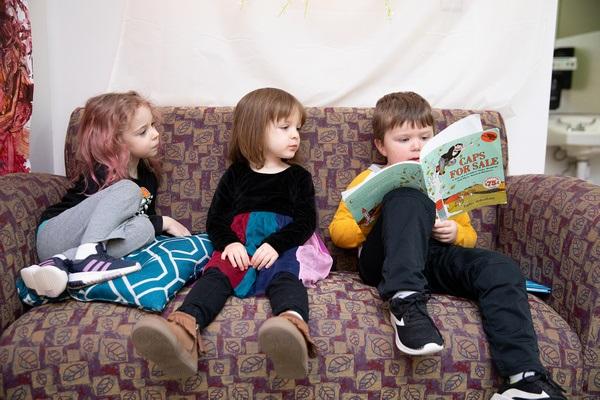
8.4 Fostering Emergent Readers
The early childhood educator has an important role to play in the conceptual, procedural, and generative knowledge development of young readers. The previous sections of this chapter discussed how to help students understand what reading is all about (conceptual knowledge) and what specific skills and concepts children need to build their emergent reading capacity (procedural knowledge). This section will address instructional strategies and assessment options to support conceptual and procedural knowledge development. It will also extend to generative knowledge, or the application of these skills and concepts in real world settings.
8.4a Instructional Strategies for Emergent Readers
Once early childhood educators understand the skills and components of emergent reading development, they can be intentional about the instructional strategies they utilize in the classroom. Using targeted instructional strategies helps maximize student learning and creates the environment for children’s literacy to thrive. Intentional literacy practices also allow educators to provide instructional modifications and supports to scaffold students’ learning as well as create inclusive literacy experiences. There are an infinite number of ways that educators can create intentional, inclusive literacy experiences. However, this section will discuss four categories of instructional practices that all early childhood educators should strive to incorporate: developing print-rich environments, playing with language, creating play-based text experiences, and providing diverse reading experiences. Figure 8.5 includes instructional practices for promoting emergent reading development in each of these four areas.
8.4a1 Developing print-rich environments. Chapter Five of this textbook talks extensively about the importance of attending to the environment and how it can support literacy learning. Looking specifically at emergent reading development, it is critical that children see text used in meaningful ways in their learning environment. Regular exposure to common words, names, and items in their classroom can have a significant impact on students’ emergent reading abilities. Showing children how text works in meaningful contexts also further promotes children’s understanding that reading is about making meaning. For instance, many teachers label parts of the classroom and frequently-used items (e.g., cubbies with children’s names, centers, the sink). Educators can also intentionally focus on diversifying the types of print in the classroom as well as how children notice and use the available print materials.
8.4a2 Playing with language. In addition to surrounding students with meaningful print, educators can foster a playful stance towards language. This intentional posture shows children that learning about reading can be fun, and reduces the stress that can come with learning about a new language system. Playing with language is a way to help students investigate how words and sounds can be manipulated. Having a focus on language play also frees us to immerse children in repeated readings as well as repeated engagement with songs, rhymes, and games that children love. It is not uncommon for children under five to find a book or song that they love and want to hear over and over. Encouraging these repeated exposures while also continuing to provide new text-based language play is the key to developing strong emergent reading skills. Chapter Seven of this textbook discusses the important role language plays in children’s broader literacy development.
8.4a3 Creating play-based text interactions. Because play is the primary vehicle for young children’s learning, early childhood educators have the opportunity to work from this area of strength and comfort. Finding logical extensions to children’s play that incorporate text interactions requires the educator to pay attention to children’s interests and match the work they are doing in their play with authentic materials. This could include strategically placing certain materials in a center (e.g., restaurant menus in the dramatic play center) or inquiring if children would like to incorporate text into an activity (e.g., asking children if they would like to bring some of the materials from the writing center over to make signs for the road they are building in blocks). Maintaining an intentional and inclusive focus on embedding developmentally appropriate text allows students to use play to act out proficient reader behaviors.
8.4a4 Providing diverse reading experiences. One of the most important actions that early childhood educators can take is regularly providing children with diverse reading experiences. In order to get good at reading, we need to see and hear proficient readers in action. Reading a variety of texts aloud exposes children to the many purposes of reading. It also builds children’s vocabulary knowledge, develops their understanding of how print works, and helps them know what to expect from certain types of text. For instance, the more fiction stories that adults share with students, the more quickly they begin to understand the elements of narrative text (e.g., characters, setting, problem/solution) and use them to aid comprehension. Young children who have been exposed to a variety of texts will quickly see how the elements of a narrative story are different from their favorite non-fiction dinosaur book, which uses photographs, captions, and labels to share factual information. While children are not actually reading in most of these experiences (decoding and understanding the words independently), they are developing foundational understandings about print that will support their development from an emergent to an early, beginning reader.
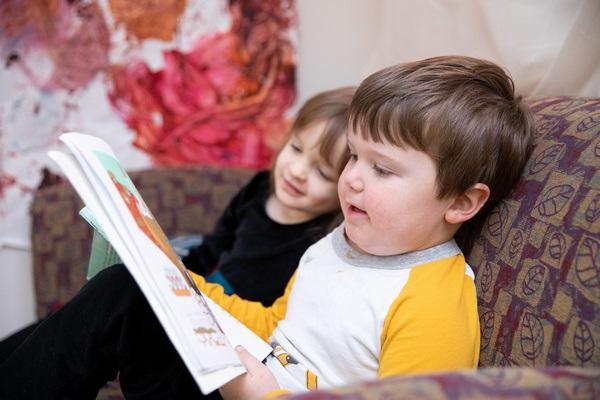
Table 8.5 “Instructional Practices That Support Reading “

- Label classroom spaces and objects using words
- Use names of children throughout the room
- Find meaningful symbols and pictures to support children’s access to materials
- Infuse familiar text into centers
- Create print materials designed by the students
- Supply nonfiction and fiction texts
- Display student work with documentation (adult dictates student’s ideas and posts next to their artwork)
- Diversify print materials (magazines, travel brochures, menus, etc.)
- Share nursery rhymes and poems
- Sing songs throughout the day (transition times, good morning greeting)
- Read and revisit rhyming books encouraging children to say common refrains
- Select a word of the day/week (have children use, draw, find, etc. the word)
- Teach children idioms, alliterations, and other fun ways to play with words
- Use children’s names to examine letter names, sounds, and shapes
- Build on students’ interest in letters and words
- Use felt boards and options for children to create their own story or retell a familiar story
- Provide puppets and a space for a “theater” to allow children to develop puppet shows
- Develop a space for drawing and writing with various tools
- Design a dramatic play area with familiar items from home (including text-based items)
- Observe children’s play and find ways to bring in text materials to enhance their experiences
- Develop signs or labels that children can use in their play
- Dictate words for students to record experiences
- Engage in daily read alouds of age-appropriate texts
- Build in independent reading time where students can select their own books to “read” and retell using pictures and background experience
- Develop small group and buddy reading moments
- Regularly engage in shared reading where the teacher models their thinking about a text
- Reread familiar and loved stories
- Allow children to participate in interactive reading where they help the teacher “read” parts of the book
- Use print referencing techniques to point out elements of the text (e.g., page numbers, title, where to start reading, the direction of the text, author and illustrator)
- Examine text features of non-fiction books (e.g., table of contents, glossary, maps, charts, labels)
8.4b Literacy Assessments for Emergent Readers
There are a number of assessment options to understand what students know about the constrained skills of phonological awareness, alphabetic principle, and concepts of print as well as the continuous components of comprehension, vocabulary, and fluency. Chapter 6 of this textbook discusses many purposes, types, and uses of both formal and informal assessment options for literacy. Because young children, birth to age five, are typically showing emergent reading abilities but are not yet proficient readers, observation is the early childhood educator’s most important tool. Carefully watching children as they interact in whole groups, small groups, and individual settings can tell us a lot about what children know about reading and what they are ready to learn. Additionally, it is critical that educators develop methods of documenting these observations over time.
Educators can use assessment options such as anecdotal notes, observational checklists, and artifacts (see Chapter 6 for further explanation) to document children’s emergent reading behaviors. For instance, we may observe an older four-year old child showing signs that they have mastered the alphabetic code (e.g., the child can name all the letters easily) and are ready to start a more focused look at the connection between letters and sounds as well as familiar words in their environment. However, we may also observe significant lags in development (e.g., the child demonstrates indicators of early and later infancy at 3 years of age). Observational assessment options can be just as important to document these concerns. Using well-constructed assessments can open up discussions with families and caretakers about factors impacting the child’s reading development and serve as a guidepost for what supports the child needs to continue building their reading foundation. Intentionally selecting emergent literacy assessment routines and practices ensures that our instructional strategies will match students’ needs.
Pause and Consider: Round is a Tortilla
Moira, Angela, and José have been spending a good deal of time in the art center recently. The teacher, Mrs. Peters, has watched as they used construction paper, stencils, and markers to design new pieces of artwork. The children have been especially interested in the shape stencils after the class read the book, Round is a Tortilla (Thong, 2015). Mrs. Peters asked the children if they would like to find the words to label their shape artwork. They eagerly agreed that this was a good idea and ran to grab the book from the classroom library. Mrs. Peters helped them locate the words: circle, triangle, rectangle, square, oval, and star. She then wrote the shape words on index cards and left the children to decide how to incorporate these words into their work. After some discussion, the children decided that they should divide up the words so each child gets two shapes. Then they spread out the shape pictures they had done and took turns adding shape words to each picture. Mrs. Peters walked by the center a few times during their play and noted how Moira and José were easily naming each shape word as they labeled the pictures and were saying the name of each letter as they wrote on the artwork, but Angela kept looking up for confirmation from her peers about which word matched each shape and was having difficulty saying the letter names as she labeled the pictures.
Identify the instructional practices Mrs. Peters incorporated to support the students’ literacy development. How should Mrs. Peters utilize assessment tools to document the students’ knowledge and abilities?
Key Take-Aways
Additional Resources
Center for Early Literacy Learning http://www.earlyliteracylearning.org/index.php
Literacy for Children with Combined Vision and Hearing Loss http://literacy.nationaldb.org/index.php/literacy-development-continuum/
Virginia Unified Early Learning and Development Standards for All Children Ages Birth-5: https://tinyurl.com/3y9epzkw
References
Beck, I. L., & Juel, C. (1995). The role of decoding in learning to read. American Educator, 19, 8-25.
Chall, J. S. (1996). Stages of reading development (2nd ed.). Harcourt Brace College Publishers.
Clay, M. M. (1991). Becoming literate: The construction of inner control. Heinemann.
Copeland, S.R., & Keefe, E.B. (2007). Effective literacy instruction for students with moderate
or severe disabilities. Paul. H. Brookes Publishing Co.
Dehaene, S. (2009). Reading in the brain. Penguin Books.
Duncan, G. J., Claessens, A., Huston, A. C., Pagani, L. S., Engel, M., Feinstein, L., Engel, M., Brooks-Gunn, J., Sexton, H., Duckworth, K., & Japel, C. (2007). School readiness and later achievement. Developmental Psychology, 43, 1428-1446. https://doi:10.1037/0012-1649.43.6.1428
Geary, D. C. (1995). Reflections of evolution and culture in children’s cognition. American Psychologist, 50, 24–37.
Goswami, U. (2002). Early phonological development and the acquisition of literacy. In. S.B. Neuman & D.K. Dickinson (Eds.), Handbook of early literacy research (pp. 111- 125). Guilford Press.
Lonigan, C. J., Burgess, S. R., & Anthony, J. L. (2000). Development of emergent literacy and early reading skills in preschool children: Evidence from a latent-variable longitudinal study. Developmental Psychology, 36, 596–613.
Nagy, W. (2009). Understanding words and word learning: Putting research on vocabulary into classroom practice. In S. Rosenfield & V. Berninger (Eds.), Implementing evidence-based academic interventions in school settings (pp. 479-500). Oxford University Press.
National Center for Deaf Blindness. (2020). Shifting the perspective. Retrieved April 8, 2021 from http://literacy.nationaldb.org/index.php/welcome/
Puranik, C.S., & Lonigan, C.J. (2014). Emergent writing in preschoolers: Preliminary evidence for a theoretical framework. Reading Research Quarterly, 49(4), 453–67.
Scarborough, H. S. (2002). Connecting early language and literacy to later reading (dis)abilities: Evidence, theory, and practice. In. S.B. Neuman & D.K. Dickinson (Eds.), Handbook of early literacy research (pp. 97- 110). Guilford Press.
Sénéchal, M., LeFevre, J., Smith-Chant, B. L., & Colton, K. V. (2001). On refining theoretical models of emergent literacy: The role of empirical evidence. Journal of School Psychology, 39, 439–460.
Shanahan, T. (2006). Fluency in the context of literacy instruction. In T. Raskinski, C. Blachowicz & K. Lems (Eds.), Fluency instruction: Research-based best practices (pp. 21-38). Guilford Press.
Snow, C. E. (1983). Literacy and language: Relationships during the preschool years. Harvard Educational Review, 53, 165–189.
Snow, C. E. (1983). Literacy and language: Relationships during the preschool years. Harvard Educational Review, 53, 165–189
Thong, R. (2015). Round is a tortilla. Chronicle Books.
Virginia Board of Education. (2021). Virginia’s early learning & development standards (ELDS): Birth-five learning guidelines. https://www.doe.virginia.gov/early-childhood/curriculum/va-elds-birth-5.pdf
Whitehurst, G. J., & Lonigan, C. J. (2002). Emergent literacy: Development from prereaders to readers. In S. Neuman & D. Dickinson, Handbook of early literacy research (pp. 11-29). Guilford Press.
Wolf, M. (2007). Proust and the squid: The story and science of the reading brain.
Image Credits
Figure 8.1: Leslie La Croix and Kalyca Schultz. “Framework for Developing Emergent Literacy.” CC BY 2.0.
Additional Images
Image, Section 8.2a: Kalyca Schultz. “A Child’s Drawing With Captions Written By An Adult.” CC BY-NC 2.0, derivative image using untitled image, (https://pixabay.com/photos/sun-children-drawing-image-drawing-451441/) by joduma, Pixabay License.
Image, Section 8.2c: U.S. Department of Education. “Teacher Reading With Child.” CC BY 2.0. (retrieved from https://bit.ly/3tHPtfH)
Image, Section 8.3: Longwood University. [Teacher and Child Reading] CC BY-NC-SA 2.0.
Image, Section 8.3b4: Longwood University. [Child Reading Morning Message] CC BY-NC-SA 2.0.
Image, Section 8.3c: Longwood University. [Children Reading Together] CC BY-NC-SA 2.0.
Image, Section 8.4a4: Longwood University. [Children Reading] CC BY-NC-SA 2.0.

